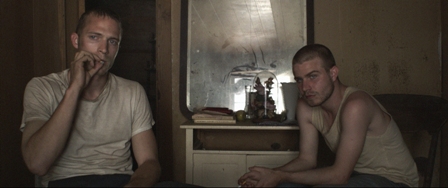2010.10.27
[Interviews]
natural TIFF "Two Gates of Sleep" Interview with Alistair Banks Griffin(Director) (10/27)


©2010 TIFF
---Did you have any model for the kind of film you wanted to make?
I wanted to catch some of the essence of what Paul Schrader called "transcendental cinema." I was looking closely at Robert Bresson, as well as Tarkovsky, and trying to bridge what I see as American and European cinema styles. Paul Schrader wrote a book that was a road map between the two styles. I used that and what Bresson wrote about directing performances in the context of a film. But the actors were heavily involved from the beginning, particularly Brady Corbet. We discussed the fact that we wanted to make a film with minimal dialogue, but the script was very detailed. It had a great deal of dialogue and monologues, which were later taken out.
---I had imagined that the script was just a series of camera placements.
All the detail was in the script, including the sound. But there was also a lot of character interaction on the page because I wanted the actors to know that even if I didn't necessarily shoot it. It was just to have them understand for the sake of process. I was interested in William Faulkner and how he wrote internal monologues. In a film like this, that process would probably resemble what Terence Malick does with grand voiceovers and overture music, but I wanted much less, something closer to a silent film. I'm not really interested in exposition or even story. I really wanted to cause a visceral response. It's not a realist film.
---Where did the original idea for the setting and the situation come from?
They came from my childhood. I was living in a city not far from this area. My family would travel there on the weekends. We discovered this little patch when I was about ten years old and built a small cabin. I started interacting with the other children who lived deep in the forest. They were completely cut off from the real world. I was probably the only person they knew from the city.
---Where is this?
It's in southern Mississippi. During Hurricane Katrina this area was the most devastatedŌĆĢmore than New Orleans, more than the Gulf Coast. A lot of people died.
---Did you film in this area?
Yes. I started the script well before Katrina, and when the hurricane happened I was upset. The visual landscape I had originally imagined was lush. It was a much more fantastical place. Post-Katrina, it just looked dead. I was really discouraged at first, but I knew it had to be in that location, a place I felt connected to and had complete control of.
---How did those changes affect the final film?
What happened was the undergrowth that had been lying dormant for 600 years just shot up, and it really transformed the area. The script changed. It was now about the connection between change and life. I wanted it to be hopeful in a way.
---But the tone is ominous. The characters seem to be overwhelmed by nature.
That's because I was using this idea of Bresson, who thought of actors as models rather than conventional actors.
---You mean, not as agents for the plot, but as forms that occupy space.
His characters move through landscapes and frames that are not normal or realistic. What he would doŌĆĢand what we didŌĆĢwas ask the actors to make the minimal amount of movement. No gesturing, no facial expressions. I didn't want anything they did to indicate what was going on in their heads. And through that process everything became flat. I don't mean one-dimensional in terms of the image, but flat in the sense that a human being is just as important as a tree.
---The only expository use of dialogue is the scene when the doctor visits the brothers.
That was a moment when I needed to ground the film at some level so it wasn't just some grand movement through time. I felt it was the right part of the movie to give the audience something to explain the brothers' actions and where they were heading.
---The actors didn't have any identifiable accents. What that on purpose?
Yes. For me, shooting in that particular place was important, but you knowing where it is was not. I wanted the viewer to feel disoriented, so during much of the movie there is very little visual information that tells you this is today or 20 years ago. My production designer and I tried to assemble sets and props and costumes that could be from the turn of the 20th century or from right now.
---It's also difficult to understand the mother's condition and her emotional relationship to her sons.
It's the same thing. I wanted all these elements to be detached, purposely. I have back stories for the mother and back stories for the boys that are deeply worked through, but I wasn't interested in making them clear. I wanted a different type of presentation of a story, more like a cave drawing than a story.
---The final journey down the river is archetypal. Where did that idea come from?
I just got it from traveling down that river so many times myself. Rivers play an important role in classical literature and I was subtly trying to bring those ideas into the movie. There's that long shot of the two brothers moving down a narrow part of the river, and then it opens up and gets wider and wider. It's swallowing them as they move through it. They become figures in the landscape, until only one of them is left with the coffin.
-How do you think the movie fits into the natural TIFF section?
I was excited about the category. My film and another film in the section, "Le Quattro Volte", were in the same section in Cannes, too, in a similar context. Both have minimal dialogue and a de-emphasis on actors. I think it's a specific trend in cinema this year. You can see it in the Cannes Grand Prix winner, "Uncle Boonmee Who Can Recall His Past Lives". They also thought (Terence Malick's) "Tree of Life" was going to be there this year. I think they were anticipating a nature groundswell in movies.

©2010 TIFF
---There are two theories about nature. One says that man is an intrinsic part of it and the other is that he is at odds with it.
I think there's room in between. I talked to Brady about that because his character believes that he is in sync with this world, but there's something hypocritical about the character's attitude.
---In the scene where he is gutting the deer he looks as if he's going to be sick.
He does get sick. It's a visceral reaction. We had consultants there because he had never done that before. We only had one chance to do it because this deer had died on a farm and had been brought to us. It was our only opportunity. They said that every time they did itŌĆĢand they'd done it hundreds of timesŌĆĢthey threw up every time. So I left that detail in, since it showed reverence for nature. You see this process of him butchering the deer and then they're eating it in the next scene. It's a cycle. In the beginning he's dragging a deer through the forest, and in the end he's dragging a coffin up a bank. And in that way it encompasses this idea of natural TIFF. I was trying to establish a web of meaning between all those things but in a visceral way. This is their function in the world, and it can relate to things outside of a natural setting, even to somebody in an urban environment.
---So that place where he buries the mother, was that always in your mind?
Actually, it doesn't exist. That's a special effect. It's a model of a tree. Maybe I shouldn't say that (laughs).
---Meaning, it's not natural.
Well, it's natural in that I made it out of a real tree, but it's only about this big. (one meter high) There's actually a fair amount of special effects in the film, additions to the landscapes. I knew exactly the kind of frames I wanted and there were some things I could only accomplish with special effects.
(Interviewed by Philip Brasor)
Two Gates of Sleep

©Ouroboros Productions, LLC




